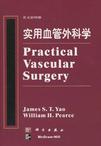实用血管外科学
2000-9
科学出版社
JamesS.T.Yao,
In recent years vascular surgeons have been caught up in the enthusiasm over newtechnology. This new technology has provided minimally invasive approaches fortreating a wide variety of vascular diseases. Unfortunately, this new technology isuntried, and long-term results are scant. Although it is important to stay abreast ofnew developments, it is also important to review traditional techniques for treatingvascular disease. These techniques have provided us with sound, durable treatments.The purpose of this book is to focus on the practical aspects of vascular surgeryencompassing office practice, critical care, critical pathways, simplified operative ap-proaches, and standard surgical procedures. In the current economic environment, itis important that our treatments be efficient, cost-effective, and durable. By criticallyreducing excesses in diagnostic modalities and limiting long-term follow-up protocols,standard vascular surgical procedures will compete satisfactorily with the newer endo-vascular techniques that may be more appealing on the surface, but may be less durable.
《实用血管外科学(英文影印版)》由美国芝加哥西北大学医学院的JamesS.T.Ya0教授和WilliamH.Pearce教授主编,有69位全球知名的血管外科专家参加编写。全书阐述血管疾病的手术和非手术治疗,重点在于新技术、新进展,并就血管疾病的确诊、影像学技术及监护等新课题进行讨论。全书图文并茂,实用性强。
编者:(美国)姚(James S.T.Yao) (美国)皮尔斯(William H.Pearce)
Contributors Preface I. PRACTICE OF VASCULAR SURGERY IN ACHANGING ENVIRONMENT1. Medicare, Present and Future: Forces for ChangeHugh H. Trout III2. Impact .of Critical Pathways on Surgical Outcome andHospital StayJoseph R. Schneider, Julie S. Droste, and John F. Golan3. The Vascular Laboratory: Quality Control and Accreditation .J. Dennis Baker4. The Vascular Center: The Concept of aMultidisciplinary ApproachAnthony D. WhittemoreII. PRACTICAL APPLICATION OF THE NONINVASIVEVASCULAR LABORATORY5. Increasing Use of Autogenous Fistulas: Selection of DialysisAccess Sites by Duplex Scanning and Transposition ofForearm VeinsMichael B. Silva, Jr., Peter J. Pappas, Frank T. Padberg, Jrand Robert W. Hobson II6. Appropriateness of Noninvasive Follow-Up forVascular ProceduresDennis F. Bandyk7. Duplex Imaging for Chronic Venous InsufficiencyD. E. Strandness, Jr8. Vein Mapping for Infrainguinal BypassesMark A. Mattos and David S. SumnerIII. PREOPERATIVE EVALUATION9. Hypercoagulable DisordersDonald Silver10. Guidelines for Preoperative Cardiac EvaluationJohn W. Hallett, Jr11. Choice of Diagnostic Tests in Patients Suspected of HavingExtracranial Carotid DiseaseWilliam D. Turnipseed12. Choice of Imaging Techniques in Patients withAortic AneurysmsBernardo D. Martinez and Christopher K. ZarinsIV. CEREBROVASCULAR ISCHEMIA13. Streamlining Hospital Care for Patients UndergoingCarotid Endarterectomy M. Ashraf Mansour and William H. Baker14. Coronary Artery Bypass Grafting with Carotid EndarterectomyThomas Bilfinger, Michael Petersen, and John J. Ricotta15. Surgery for Asymptomatic Carotid Artery Disease:Is It Cost-Effective?Jack L. Cronenwett and John D. Birkmeyer16. Cost-Effectiveness of Carotid Endarterectomy in the Preventionof StrokeSheela T. Patel and K. Craig KentV. SURGERY OF THE AORTA AND ITS BODY BRANCHES17. Contemporary Results of a Clamp-and-Sew Technique forThoracoabdominal Aortic Aneurysm RepairRichard P. Cambria18. Treatment Options for Aortoiliac Occlusive DiseaseDavid C. Brewster19. Management Options for AtheroembolizationRichard R. Keen and James S. T. Yao20. Management of Visceral Artery AneurysmSandra C. Carr and William H. Pearce21. Surgical Options in the Treatment of RenovascularHypertension and Renal FailureJames C. StanleyVI. LIMB ISCHEMIA DUE TO INFRAINGUINAL ARTERIALOCCLUSIVE DISEASE22. Using Low Molecular Weight Heparin for AnticoagulationAfter Lower Extremity Arterial BypassWalter J. McCarthy III and William D. McMillan23. Management of Inguinal Wound Healing:Complications of Inguinal WoundsJonathan B. Towne and Douglas A. Coe24. Nonoperative Management of FemoropoplitealOcclusive Disease Lloyd M. Taylor, Jr., Gregory L. Moneta, and John M. PorterVII. NONOPERATWE MANAGEMENT OFVASCULAR PROBLEMS25. Simplified Approach to Thrombolytic Therapy of Arterial andGraft OcclusionAnthony J. Comerota and Michael D. Malone26. The Management of Mesenteric Venous ThrombosisMichael C. Dalsing27. Nonoperative Treatment of Femoral PseudoaneurysmsSteven S. Kang and Nicos Labropoulos28. Deep VenoUs Thrombosis: Catheter-DirectedThrombolytic TherapyRobert L. Vogelzang and Mark W. MewissenVIII. TRAUMA AND EMERGENCY SURGERY29. A New Strategy in the Resuscitation of Trauma Patients . Kenneth L. Mattox30. Carotid Trauma: When to OperateDavid V. Feliciano31. Noninvasive Tests in the Diagnosis of Vascular Trauma . Kaj Johansen32. Endovascular Techniques in the Treatment of PenetratingArterial TraumaTakao Ohki and Frank J. VeithIX. VENOUS PROBLEMS33. Understanding and Managing Thromboembolism in Patientswith MalignancyMary C. Proctor and Lazar J. Greenfield34. Acute Deep Vein Thrombosis: Outpatient TreatmentDavid Green35. Hematologic Factors in Recurrent Venous ThrombosisThomas W. Wakefield and Alvin H. Schmaier36. The Fate of Calf Vein ThrombosisMark H. Meissner37. Primary Varicose Veins and Their TreatmentJohn H. Scurr38. Venous Reflux and Chronic Venous InsufficiencyAndrew W. Bradbury and C. Vaughan Ruckley39. Impact of Superficial Venous Reflux in ChronicVenous InsufficiencyFrank T. Padberg, Jr. and Robert W. Hobson II40. Treatment Strategies for Venous Leg UlcersVincent Falanga41. New Techniques for Sclerotherapy of Spider Veins andSmall Varicose VeinsJohn R. Pfeifer, Roger Higgins, Brian G. Brazzo, and Frank A. NesiIndex
插图:Ultrasound scans of the superficial venous system are initiated at the wrist of thenondominant arm with a tourniquet placed at midforearm.Superficial veins in theforearms are dilated by tapping and stroking maneuvers.Warm ultrasonic鼯1(Therma-sonic,Parker Labs,Orange,NJ)is applied and the veins insonated using a 5 MHz or7 MHz scanning probe(Accuson,128 XP一10).Veins are assessed for compressibilitvand diameter.The tourniquet is then moved to the arm and forearm.and veins ofacceptable diameter are followed proximally for confinuity and size.At the antecubitalspace,continuity with arm veins is verified.The tourniquet is then removed andcontinuity of the deep system determined through the axillary and subclavian veins.The superficial forearm veins most suitable for use,as identified by DU,are mappedby skin markings for use in the operative procedure.Once the venous anatomy is determined tO be acceptable for AF.segmental arterialpressures are measured and the status of the radial arterv is evaluated.Diameter ofthe radial artery at the wrist is measured and the radial artery scanned bv DU.Thepatency of the palmar arch is verified.If the radial arterv is not suitable,the ulnar andbrachial arteries are examined for possible use as alternative sources of arterial inflow.Evaluation of the dominant arm is performed only if evaluation of the nondominantarm proves unsatisfactory.Skin overlying the most suitable segment of artery is marked.Patients requiring immediate dialysis and yet noted to have suitable arteries andveins for AF formation are evaluated for concomitant placement of a contralateralinternal jugular hemodialysis catheter for use during the period of maturation.A periodof 4 tO 6 weeks is allowed for AF maturation prior to attempts at cannulation.Priorto initial access,AF are evaluated by DU,and the areas of maximal diameter are markedon the skin to facilitate needle cannulation by dialysis nursing personnel.
《实用血管外科学(英文影印版)》是由科学出版社出版的。

质量不错,内容丰富,好好学习
获益获益匪浅匪浅获益匪浅获益匪浅获益匪浅获益匪浅获益匪浅获益匪浅获益匪浅获益匪浅获益匪浅获益匪浅获益匪浅获益匪浅获益匪浅获益匪浅获益匪浅